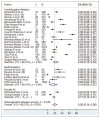Prevalence of Toxocara eggs in Latin American parks: a systematic review and meta-analysis
- PMID: 37701393
- PMCID: PMC10495062
- DOI: 10.53854/liim-3103-7
Prevalence of Toxocara eggs in Latin American parks: a systematic review and meta-analysis
Abstract
Introduction: Toxocariasis is an infection caused in canines, felines, humans, and other vertebrates by species of the genus Toxocara, such as T. canis and T. cati. The embryonated eggs of these parasites are the main form of acquisition of the infection both for definitive hosts, such as the dog and the cat, respectively and for paratenic hosts, such as humans and other vertebrates. Toxocariasis infection in humans causes visceral larva migrans syndrome. When deposited on park soils, environmental contamination becomes a risk for environmental, human, and animal health.
Objective: To systemically estimate the prevalence of Toxocara spp. eggs in park soils in Latin America.
Methods: A systematic review and meta-analysis were performed to evaluate the prevalence of Toxocara eggs in park soils in Latin America, defined by copro-parasitological, molecular and immunological techniques. We searched PubMed, Scopus, Web of Sciences, Embase, LILACS and SciELO for studies published from 1900 through 28 January 2023. A meta-analysis was performed using a random-effects model to calculate the pooled prevalence and 95% confidence intervals (95% CI). Heterogeneity was measured through I2 statistics.
Results: Forty-nine studies (2,508 parks and 12,833 samples) were included, of whom 44 had a low risk of bias. The pooled prevalence of Toxocara eggs in parks in Latin America was 50.0% (95% CI: 40.0%-60.0%). Argentina had the highest prevalence of Toxocara eggs in parks (100%), followed by Brazil (66%) and Venezuela (63%). The pooled prevalence of Toxocara eggs in soil samples was 20.0% (95% CI: 14.0%-26.0%); in faecal samples, it was 13.0% (95% CI: 6.0%-23.0%).
Conclusion: The presence of Toxocara canis eggs in public parks in Latin America is a zoonotic and public health threat for the people who go to these places, especially if children play on the ground with dirt or contaminated objects; since many pet owners and general public are not adequately informed about the mode of transmission of this parasite.
Keywords: Latin America; Toxocara; meta-analysis; park; prevalence; systematic review.
Conflict of interest statement
Declaration of competing interest The authors declare no conflicts of interest.
Figures







Similar articles
-
Toxocara cati Infection in Cats (Felis catus): A Systematic Review and Meta-Analysis.Animals (Basel). 2024 Mar 27;14(7):1022. doi: 10.3390/ani14071022. Animals (Basel). 2024. PMID: 38612261 Free PMC article. Review.
-
Environmental contamination with Toxocara spp. eggs in public parks and playground sandpits of Greater Lisbon, Portugal.J Infect Public Health. 2018 Jan-Feb;11(1):94-98. doi: 10.1016/j.jiph.2017.05.002. Epub 2017 May 22. J Infect Public Health. 2018. PMID: 28545900
-
[Toxocara spp. and other helminths in squares and parks of Ciudad Bolívar, Bolivar State (Venezuela)].Enferm Infecc Microbiol Clin. 2008 Jan;26(1):23-6. doi: 10.1157/13114391. Enferm Infecc Microbiol Clin. 2008. PMID: 18208762 Spanish.
-
Soil Contamination with Toxocara Spp. Eggs in Public Parks of Mashhad and Khaf, North East of Iran.Iran J Parasitol. 2015 Apr-Jun;10(2):286-9. Iran J Parasitol. 2015. PMID: 26246828 Free PMC article.
-
The epidemiology and public health importance of toxocariasis: a zoonosis of global importance.Int J Parasitol. 2013 Nov;43(12-13):999-1008. doi: 10.1016/j.ijpara.2013.07.004. Epub 2013 Aug 14. Int J Parasitol. 2013. PMID: 23954435 Review.
Cited by
-
Association of Neuroblastoma (NB) SH-SY5Y Cells with Antibodies of Parasitic Origin (Anti-Acanthamoeba and Anti-Toxocara canis).Int J Mol Sci. 2024 Dec 19;25(24):13577. doi: 10.3390/ijms252413577. Int J Mol Sci. 2024. PMID: 39769340 Free PMC article.
-
Toxocara cati Infection in Cats (Felis catus): A Systematic Review and Meta-Analysis.Animals (Basel). 2024 Mar 27;14(7):1022. doi: 10.3390/ani14071022. Animals (Basel). 2024. PMID: 38612261 Free PMC article. Review.
References
-
- Rodriguez-Morales AJ, Bonilla-Aldana DK, Gallego-Valencia V, et al. Toxocariasis in Colombia: More Than Neglected. Curr Trop Med Rep. 2020;7(1):17–24.
-
- Rodríguez-Morales AJ, Echeverri-Cataño LF, Delgado O. Need for a consensus in the diagnosis of human toxocariasis: implications for the latin american public health. Rev Per Med Exper Salud Pub. 2011;28(1):161–162. - PubMed
-
- Aghaei S, Riahi SM, Rostami A, et al. Toxocara spp. infection and risk of childhood asthma: a systematic review and meta-analysis. Acta Trop . 2018;182:298–304. - PubMed
-
- Merigueti Y, Santarém VA, Ramires LM, et al. Protective and risk factors associated with the presence of toxocara spp. eggs in dog hair. vet Parasitol . 2017;244:39–43. - PubMed
Publication types
LinkOut - more resources
Full Text Sources
Miscellaneous
